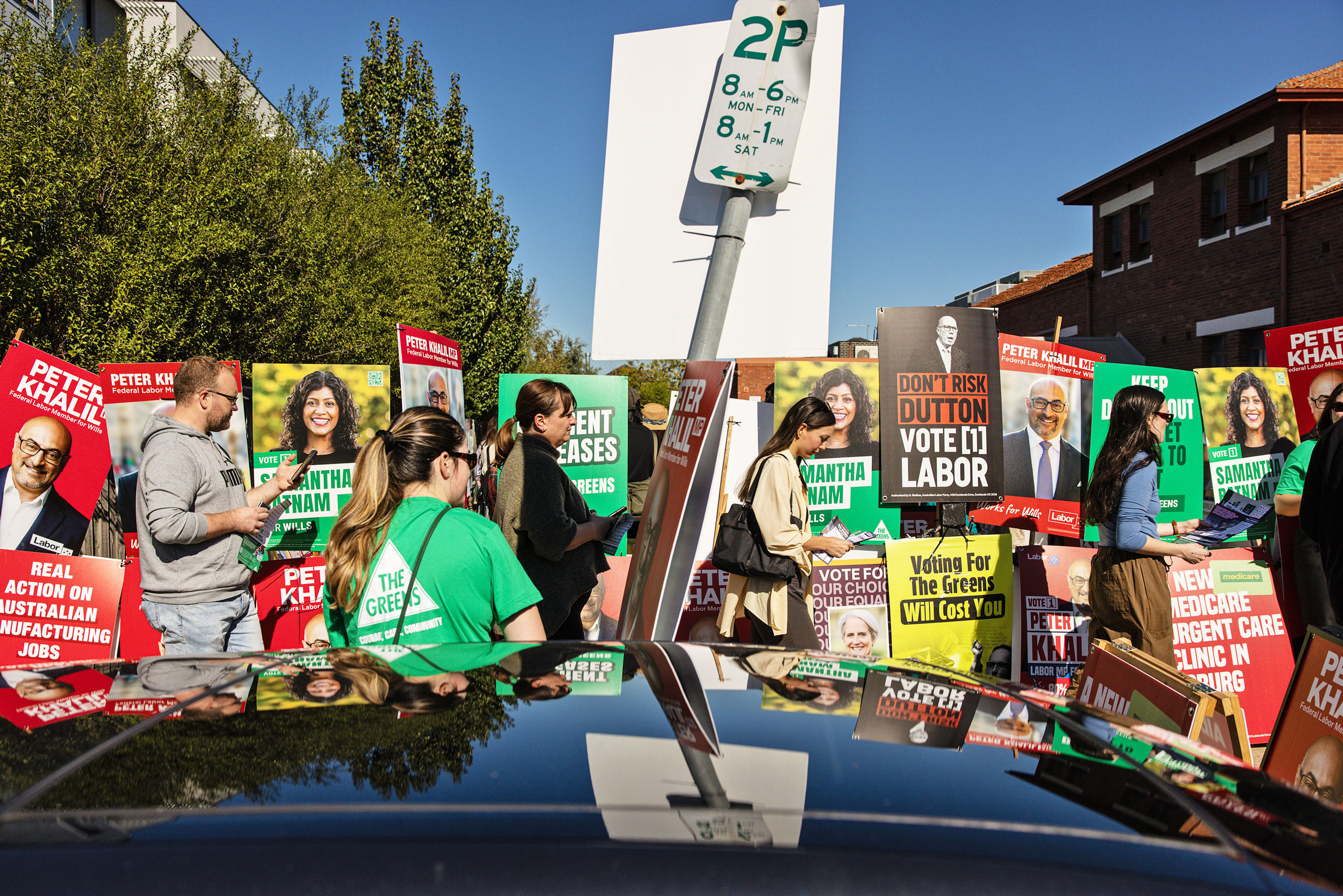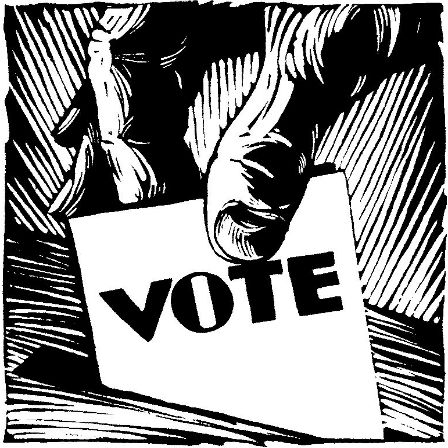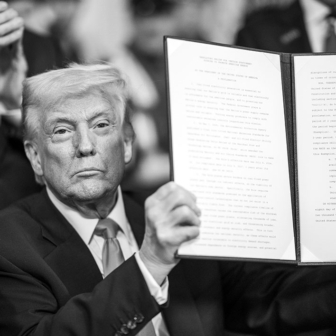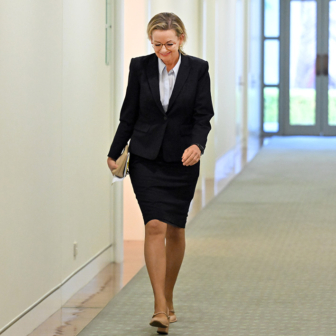Young voters are back! Or maybe they never left.
Articles and talk programs pondering whether the youth vote “might decide the outcome this time” have been staple pre-election fillers for decades. Along with other demographic ruminations, they usually disappear on election night as their meaninglessness becomes evident: once again, the election is decided by all voters.
A related meme followed the demise of the Howard government in 2007 and Scott Morrison’s in 2022: support for the centre-right among young Australians was now so diabolically low that it was hard to see how the Coalition could win office ever again. In both cases the yarn worked a treat while the Rudd and Albanese governments were soaring in the polls but dissolved as voting intentions narrowed. From late 2023 until May 2025 not a peep was heard from anyone about this existential threat to the Libs and the Nats.
A particular version of the “youth vote” narrative did, however, step up. The “era of Baby Boomers as the dominant voting force in Australian politics is at an end,” it said. “Power and numbers have shifted to younger people” because “for the first time in Australian history, Generation Z and Millennials will outnumber Baby Boomers at the ballot box in the upcoming federal election.”
“Disillusioned” and “resentful,” these two groups’ impact on the election was impossible to predict, but “their grievances could deliver unexpected results in marginal seats” and they “may well,” yes, “decide the election.”
Today, three months after the Albanese government’s massive return, the “Coalition may never govern again” narrative is well and truly revived, with those Millennials and GenZs enjoying a central position, having morphed from unpredictable to reliably left-of-centre, not just now, but forever. Just in the last fortnight you could read about “younger voters whose electoral heft now rivals the traditionally powerful baby boomer bloc” and how “Gen Z and Millennial voters, spanning the age range from thirteen to forty-four, [have been] gradually overtaking the electorate as Baby Boomers fade away.”
Now, your takeout from all this hullabaloo might be that this is the first time voters under forty-five have outnumbered the sixty-pluses. This is not the case. That younger group has always outstripped the sixty-plus cohort, and in fact the extent to which it does shrinks with every election (perhaps excluding 1974 when the voting age dropped from twenty-one to eighteen). In June 2008 (the earliest AEC age data I could find) eighteen- to forty-four-year-olds comprised 45.8 per cent of the roll and sixty-pluses 26.6 per cent, a gap of 19.8. At the close of rolls in 2025 the numbers were 43.1 and 32.7, a difference of 10.4.
It almost halved in seventeen years: our population is ageing, after all.
No, the claim here is specific to those particular demographics, Gen Zs and Millennials, and its alleged significance rests on an assumption about their future voting behaviour: they will remain left-wing. Nearly all these yarns are sourced to polling outfit Redbridge, and usually include quotes from director Kos Samaras. Redbridge has a very fine quantitative polling record, topping Kevin Bonham’s 2025 election pollsters analysis. Along with his colleague Tony Barry, Samaras has been a staple of the ABC TV’s election night coverage in recent years.
To understand what they’re on about, we need definitions of these rather arbitrary “generations.” By most accounts, Boomers are people born from 1946 to 1964, Millennials from 1981 to 1996 and Generation Z from 1997 to 2012.
For enrolment we go to the Australian Electoral Commission’s electoral roll, provided on their splendid website, where ages are grouped mostly in five-year bunches. Mil-Gen Zs fit neatly into the forty to forty-four category plus all the younger ones. Boomers at first glance look trickier, but luckily it turns out that when Samaras et al talk about them, they actually mean Boomers and older, so the AEC’s sixty to sixty-four group is also convenient: just add it to the more aged. (Poor old Gen Xers, alone, are left out of this equation.)
Now, the reason, stated or implied, that the new outnumbering is tectonic is that Mil–GenZs are not like earlier eighteen to forty-four years olds: their political inclinations will not change much over time. Yes, they were seen as up for grabs before 3 May, but the result, or maybe the size of it, changed that. (In truth we have no data on who voted how age-wise this year, apart from pre-election polling which, remember, apparently showed volatility among young voters.) The crux of it, why this constitutes an earthquake, is that they will not follow earlier generations in becoming more politically conservative as they age.
That last bit requires a bit of fleshing out.
It’s obviously not the case that historically all Australians’ voting habits adhered to the socialist–capitalist, heart-and-head formulation. But, in net terms, a substantial minority have. Our meagre exit polling data means that any guesstimate can only be rough, and the picture is complicated by the erosion of major-party support over the decades, particularly among the young. The meaning of left and right, and the positions of the major parties, are not fixed in time. The parties evolve over the years in response to changes in popular attitudes, or for other reasons. But preferential voting does allow us to observe two-party-preferred trends, while acknowledging the decreasing applicability of that construct.
It’s also important to view any observed shift in a particular demographic’s vote in the context of the electorate as a whole. At the 2025 election, for example, the overall swing to Labor was 3.1 per cent. If you identified a cohort that had swung to Labor by 3 per cent, it would not be of great interest. But a 6 per cent swing, or no swing at all, might well be.
I have to report with some sadness that many breathless accounts of changes in voting habits over time among particular groups don’t take account of those overall shifts. Not adjusting in this way produces more drama just makes better copy.
So, with plenty of provisos, how has the ageing process affected the net shift from left to right in the wider electorate?
The best available evidence, with decent sample sizes, comes in Newspoll’s quarterly numbers, which stretch back to 1996. Twenty-nine years ago, the eighteen to thirty-four age group — not quite a perfect match for today’s fifty to sixty-four group, but not-too-bad — supported Labor at about 3 per cent above the national figure. (These are my two-party-preferred estimates from Newspoll’s primary support.)
Across last year and early this, though, Newspoll’s fifty to sixty-four group registered two-party-preferred support for Labor at around 4–5 per cent below the corresponding national number.
So, with plenty of caveats — midterm surveys are not as meaningful as exit polls because people can change their minds as election day approaches; immigration, emigration and death have changed the roll over the last thirty years; support shifts in both directions; and polls, of course, can be wrong — we seem to be talking about perhaps 7 (rounding down to account for the current group being slightly older than a perfect match would be) per cent of those voters have shifted right, or around double that, 14 per cent, of Labor ones, in two-party-preferred terms. That’s across a period of less than thirty years; today’s fifty-year-olds still have a lot of ageing to do.
So, is there really a reason to believe Mill–GenZs will buck the long-term trend and go to their graves the left-of-centre voters they are today? This is, after all, the basis on which all the drama rests.
The answer is no.
For one thing (as Zou Enlai didn’t really opine about the impact of the French Revolution) it’s just too early to tell. Even if current data suggested they haven’t shifted allegiance so far, they’re still young. But the evidence, despite some claims, doesn’t show that anyway.
The source for the assertion that their politics won’t change is usually the Australian Election Study’s 2022 report. I gave the AES a going-over a couple of years ago for various sins, including ignoring aggregate voter shifts, which is relevant here. The AES claimed that Millennials had shifted left over the decades, that they “entered the electorate in the early 2000s with about 35 per cent of this generation supporting the Coalition [in primary votes], a level which has now fallen to 25 per cent in 2022].”
The two big flaws in this finding were that the electorate as a whole recorded a 2022 Coalition primary vote 7.2 per cent lower than in 2001, and that Millennials were still turning eighteen, adding presumably relatively left-wing voters to the roll, right up until 2014. So it wasn’t a fixed group.
The AES made no similar assertions about the newly-arrived Gen Z electors, in fact had them swinging to the Coalition in 2022, albeit from an unusably tiny sample. But Redbridge has lumped them with Millennials, presumably to facilitate the “now outnumber Boomers” tagline. It makes for a very large group indeed, containing many parents and their offspring. Note that young Gen Zs will continue joining the electoral roll until around 2030.
As far as I know there has been no attempt by the AES to track the votes of subsets of Millennials, say those who are forty to forty-four in 2025 and were nineteen to twenty-three at the 2004 election (adjusting for overall electorate votes, of course). The samples would be tiny, but the results could still be of interest. In theory we outsiders should be able to do that with the public AES data, but in practice their older datasets are rather messy. I had a go a couple of years ago but hit a dead end. It was the case though, using minuscule samples, that older Mil-GenZs voted more right-wing than younger ones in 2022.
What is undoubtedly true, however, is the increased divergence between young and old voters. That roughly three-point 1996 Labor advantage among eighteen to thirty-four year olds has exploded to at least ten per cent among today’s eighteen to thirty-four year olds. This is in line with worldwide trends, though complicated by recent accounts of many young men turning to the centre-right and far-right parties.
Now, you could argue that even if today’s overwhelmingly left-of-centre young people move to the right by the same amount as their predecessors, it will still result in a very leftwing overall electorate. But it’s easy to imagine them shifting by more as they become more well-off than younger Australians. Because all the bounty held by oldies today has got to go somewhere.
Explanations for this predicted electoral seachange routinely link it to the housing crisis and increasing intergenerational wealth disparity. These are real issues: real estate ownership is increasingly skewed to older people, and skyrocketing prices, particularly over the last two decades, continue locking younger people out. It is no doubt part of the reason for the big divergence in votes by age.
But what happens to all that property and wealth when old people die? It doesn’t accompany them off this mortal coil, but is inherited by others, eventually nearly all younger Australians.
According to one 2025 account, the median age at which people get an inheritance is fifty-five and the average amount $707,000. Many, of course, will receive a lot more than that, and many a lot less. If the current age–wealth disparity is historically large, then so will be the sudden (average) increase in wealth they experience. And, of course, many young people will also, as they age, achieve the Great Australian Dream before their parents die.
So would we really expect all or nearly all Mill–Gen Zs to remain loyal to the parties that claim to promise a more egalitarian spread of home ownership and/or cheaper rents when it’s no longer in their material interests?
Or might they become more like today’s selfish, property-hogging Boomers?
When it comes to age and the electoral roll, the most important fact to remember is that the median is always increasing (it’s currently around forty-nine). And regarding electoral behaviour more generally, one of the worst things an observer can do is project the present — the last election result, the current opinion polls, today’s impression — onto the future. That usually ends in tears. •





